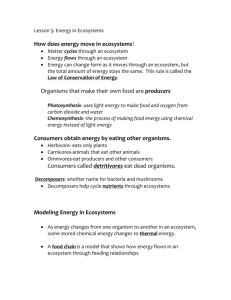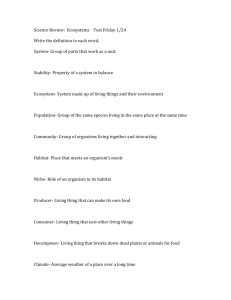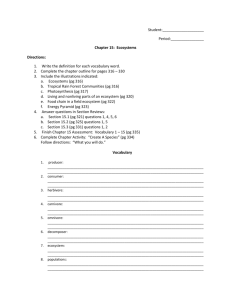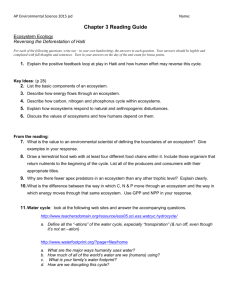Apes-ch-3
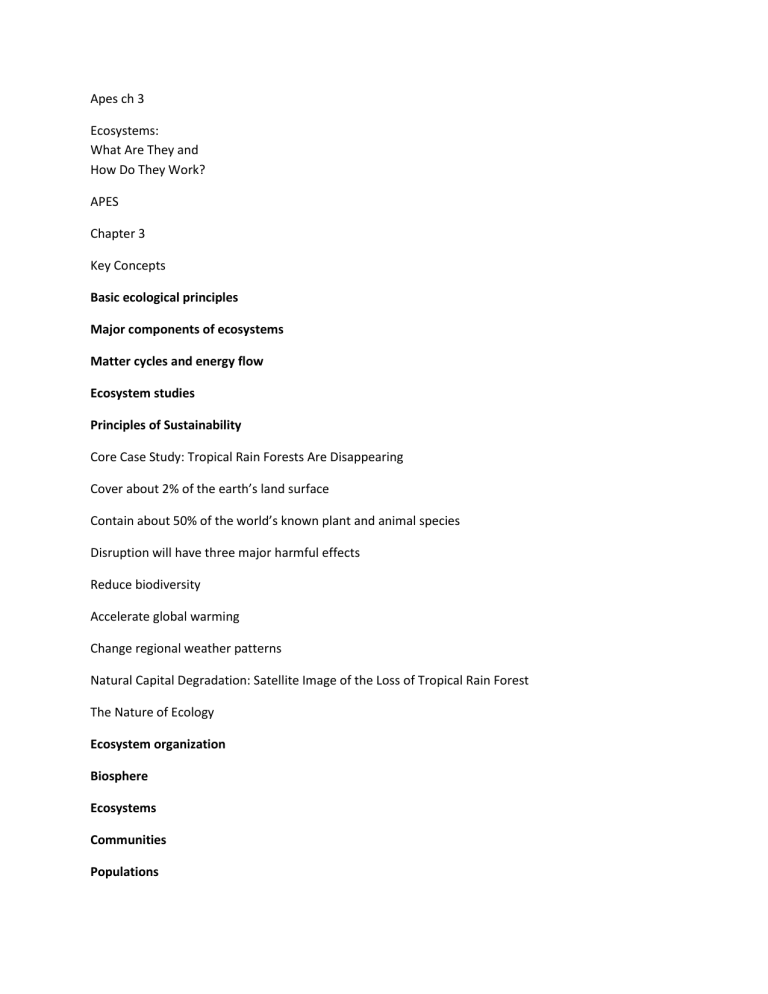
Apes ch 3
Ecosystems:
What Are They and
How Do They Work?
APES
Chapter 3
Key Concepts
Basic ecological principles
Major components of ecosystems
Matter cycles and energy flow
Ecosystem studies
Principles of Sustainability
Core Case Study: Tropical Rain Forests Are Disappearing
Cover about 2% of the earth’s land surface
Contain about 50% of the world’s known plant and animal species
Disruption will have three major harmful effects
Reduce biodiversity
Accelerate global warming
Change regional weather patterns
Natural Capital Degradation: Satellite Image of the Loss of Tropical Rain Forest
The Nature of Ecology
Ecosystem organization
Biosphere
Ecosystems
Communities
Populations
Organisms
The Earth’s Life-Support Systems
Troposphere: Sea level to 17 kilometers
Stratosphere: 17-48 kilometers (ozone layer)
Hydrosphere: All of the Earths water
Lithosphere: Earths crust and upper mantle
Biosphere: Areas on the Earth were life exists
Natural Capital: Sustaining Life of Earth
One-way flow of energy from Sun
Cycling of crucial elements
Gravity
Solar Capital: Flow of Energy to and from the Earth
Flow of Energy to and from the Earth
Natural Capital: Major Biomes
Biomes: Large terrestrial areas based on climate and specific species adapted to the area
Role of climate: Climate is the main factor that sets the biome
Aquatic life zones: The division of the water areas in the biosphere
Ecosystem Factors
Abiotic factors: Non-living factors in the ecosystem (air, water, soil, nutrients, solar energy)
Biotic factors: Living factors in the ecosystem (plants, animals, microbes)
Range of tolerance: The variations of physical & chemical factors that support a population
Limiting factors: Factors that sets the carrying capacity of the population
Ecosystem Factors
Components of Ecosystems
Abiotic chemicals
Photosynthesis
Producers (autotrophs)
Consumers (heterotrophs)
Aerobic respiration
Decomposers
Biodiversity
Genetic diversity: The variety of genetic material
Species diversity: The number of species in an area
Ecological diversity: The variety of terrestrial and aquatic ecosystems in an area
Functional diversity: The biological and chemical processes needed for survival
Energy Flow in Ecosystems
Food chains: The sequence of organisms each of which is a food source for the next
Trophic Levels: Organization of feeding levels
Food webs: Complex network of interconnected food chains
Trophic Levels
Primary consumer (herbivore)
Secondary consumer (carnivore)
Tertiary consumer
Omnivore
Detritivores and scavengers
Decomposers
Connections: Food Chains and Energy Flow in Ecosystems
Ecological Pyramids
Pyramid of
energy flow
Ecological
efficiency
Pyramid of
biomass
Pyramid of
numbers
Pyramid of Energy Flow
Primary Productivity of Ecosystems
Gross primary productivity (GPP): The rate the ecosystem converts solar energy into chemical energy
(photosynthesis)
Net primary productivity (NPP): The amount of energy from photosynthesis that is left over after the
plant use from cellular respiration
Primary Productivity of Ecosystems
Matter Cycling in Ecosystems
Biogeochemical cycles
Hydrologic cycle (H
2
O)
Carbon cycle
Nitrogen cycle
Phosphorus cycle
Sulfur cycle
Water Cycles through the Biosphere
Natural renewal of water quality: three major processes
Evaporation
Precipitation
Transpiration
Alteration of the hydrologic cycle by humans
Withdrawal of large amounts of freshwater at rates faster than nature can replace it
Clearing vegetation
Increased flooding when wetlands are drained
Hydrologic (Water) Cycle
Science Focus: Water’s Unique Properties
Properties of water due to hydrogen bonds between water molecules:
Exists as a liquid over a large range of temperature
Changes temperature slowly
High boiling point: 100˚C
Adhesion and cohesion
Expands as it freezes
Solvent
Filters out harmful UV
Carbon Cycle Depends on Photosynthesis and Respiration
Link between photosynthesis in producers and respiration in producers, consumers, and decomposers
Additional CO
2 added to the atmosphere
Tree clearing
Burning of fossil fuels
How are human activities affecting the carbon cycle?
Carbon dioxide produced by burning fossil fuels and clearing photosynthesizing vegetation faster than it is replaced can increase the average temperature of the troposphere.
The Nitrogen Cycle
Nitrogen fixation: Converting N
2
to ammonia (NH
3
) then dissolves into ammonium (NH
4
+ )
Nitrification: Converting NH
4
+ to nitrite (NO
2
)
Nitrification: Converting NO
2
to nitrate (NO3-)
Ammonification: Converting nitrogenous waste to ammonia
Denitrification: Converting nitrates to N
2
Nitrogen Cycles through the Biosphere: Bacteria in Action
Human intervention in the nitrogen cycle
Additional NO and N
2
O
Destruction of forest, grasslands, and wetlands
Add excess nitrates to bodies of water
Remove nitrogen from topsoil
The Nitrogen Cycle
Annual Increase in Atmospheric N
2
Due to Human Activities
Phosphorus Cycles through the Biosphere
Cycles through water, the earth’s crust, and living organisms
May be limiting factor for plant growth
Impact of human activities
Clearing forests
Removing large amounts of phosphate from the earth to make fertilizers
Sulfur Cycles through the Biosphere
Sulfur found in organisms, ocean sediments, soil, rocks, and fossil fuels
SO
2
in the atmosphere
H
2
SO
4
and SO
4
-
Human activities affect the sulfur cycle
Burn sulfur-containing coal and oil
Refine sulfur-containing petroleum
Convert sulfur-containing metallic mineral ores
How Do Ecologists Learn About Ecosystems?
Field research: “muddy-boots biology”
New technologies available
Remote sensors
Geographic information system (GIS) software
Digital satellite imaging
2005, Global Earth Observation System of Systems (GEOSS)
Geographic Information System (GIS)
Some Scientists Study Ecosystems in the Laboratory
Simplified systems carried out in
Culture tubes and bottles
Aquaria tanks
Greenhouses
Indoor and outdoor chambers
Supported by field research
Some Scientists Use Models to
Simulate Ecosystems
Computer simulations and projections
Field and laboratory research needed for baseline data




